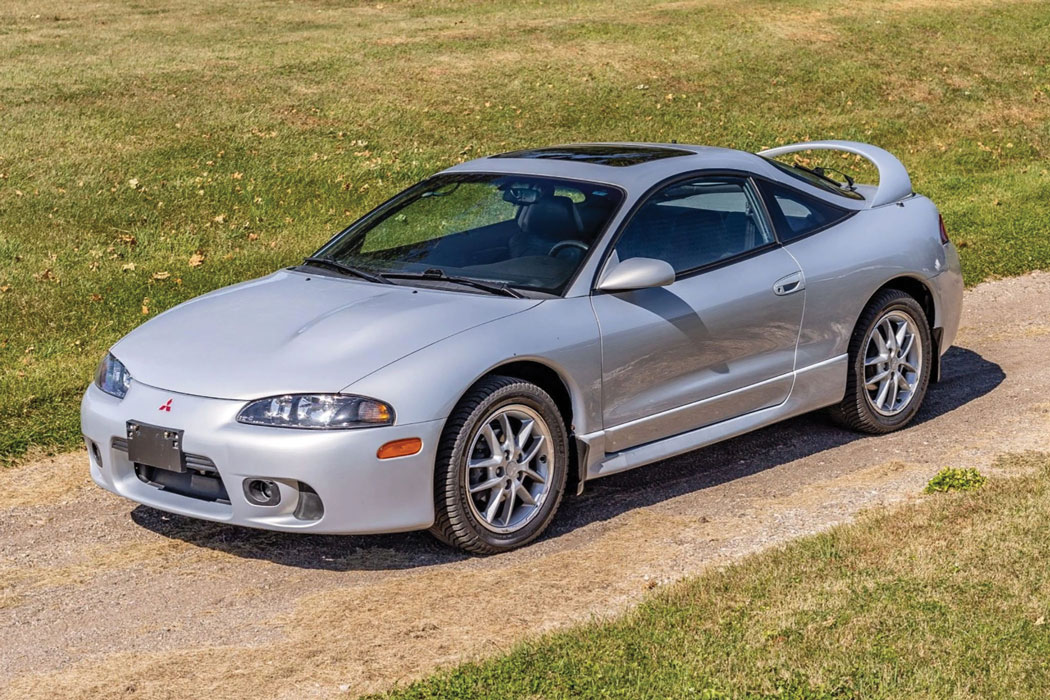
It’s nice to be first. Ask Jeff Bezos. Or Bill Gates. Or the Netflix guy. And, yes, even Mitsubishi. It didn’t nail it right out of the gate — that came later with the Lancer Evolution (see “Affordable Classic,” July 2021) — but the Eclipse GSX marked a lot of valid firsts for car enthusiasts. This sport coupe (remember when such a thing existed?) offered cheap, turbocharged, all-wheel-drive fun at a time when most Americans thought four-wheel drive was just for pickups.
In the beginning
The first-generation Eclipse rocketed out of the gate in 1990 and remained largely unchanged through 1994. It was built in Normal, IL, part of the Diamond-Star Motors joint venture with Chrysler, which sold its own Plymouth Laser and Eagle Talon clones. Collectively these came to be called “DSM cars.” There were front-drive versions and the base 4-cylinder was normally aspirated, but it was the turbocharged all-wheel-drive cars (Eclipse GSX and Eagle Talon TSi AWD) that grabbed headlines in car magazines.
The early cars made a name for themselves by outperforming many of their 2+2 contemporaries such as the Acura Integra, Ford Probe, Honda Prelude and Volkswagen Corrado. After a few years on the market, however, competitors began arriving with bigger engines and more refinement.

Second coming
For the 1995 model year, Mitsubishi fought back with a new model that offered more power (210 horsepower vs. 195), redesigned front and rear suspensions, and a slicker body. The robust, iron-block 2.0-liter 4G63 remained the untapped source of potential under the Eclipse GSX’s hood. To improve boost response, a smaller turbo hung from its exhaust manifold. With the exception of a higher compression ratio and smaller ports, the rest of the engine was largely unchanged internally. A 5-speed manual or a 4-speed automatic transmission routed power to all four wheels via a viscous center differential and viscous limited-slip rear differential was optional.
The new car added 1.6 inches between its wheel centers, increasing its wheelbase to 98.8 inches. But the big chassis change came at the front suspension, where double wishbones replaced the first-gen car’s MacPherson struts. Out back there was a new multi-link setup. The steering ratio also quickened in the second-generation cars from 15.8:1 to 14.6:1. The goals were obvious — make the second-generation car better at going around corners.
On paper, performance was outstanding: A 0–60-mph time in the mid six-second range, top speed near 140 mph, and lateral acceleration of 0.87g. All were class leading. But what looks good on paper wasn’t always amazing in the real world. These cars didn’t really communicate well at their limit, nor did they respond to inputs as quickly as some of their contemporaries. Part of the problem was a curb weight of 3,270 pounds — heavy for the mid-1990s.
Bolt-on mods
But what DSM cars did very well was respond to modifications. Bolt-ons — a bigger turbo, intercooler and exhaust, properly tuned — easily doubled power output. Done correctly, a 4G63 will survive at those power levels. (The clutch, and sometimes the transmission and transfer case, will not.) Many cars were modded and built up over the years (one appeared in the original “The Fast and the Furious” movie), and a large DSM enthusiast community developed.
Although generally robust, second-gen Eclipses, particularly those built between mid-1995 and late 1997, were plagued with crankshaft thrust-bearing failures that would lead to engine replacement. The problem reached epidemic levels for the 1996 model year. So even a show-quality, low-miles 1996 may need an engine replacement. There was also a recall issued for cars through 1998 for a transfer-case leak that could result in failure. Other parts — like OEM replacement transmission parts — haven’t been available for a decade.
Over the past few years, auction prices for DSM cars have been erratic, although they are definitely trending upward. The days of picking one up for $3,000 on Craigslist are clearly over. Since the beginning of last year, we’ve seen five GSX 5-speeds sell online for more than $25k, with one of those topping $40k. When it comes to desirability and collectibility, the manual Eclipse GSXs and AWD Talons are the cars to buy.
When narrowed down to this most desirable specification, these cars are no longer abundant. Finding a pristine car that’s not been modded, abused or neglected is rare, and it’s getting hard even to find average-condition drivers. DSM cars are worth seeking out now, before it’s entirely too late. ♦